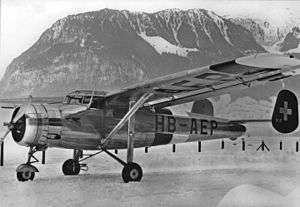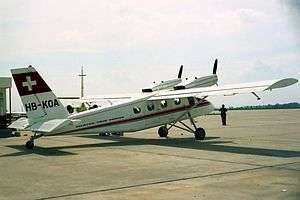Pilatus Aircraft
|
| |
| Industry | Aerospace |
|---|---|
| Founded | 10 December 1939 |
| Headquarters | Stans, Switzerland |
Area served | worldwide |
Key people |
Markus Bucher (CEO) Oscar J. Schwenk (Chairman) |
| Products | Fixed wing aircraft |
Number of employees | 1905 (June 2016) |
| Website |
www |
Pilatus Aircraft Ltd. is an aircraft manufacturer located in Stans, Switzerland. In June 2016, the company employed 1,905 people.[1]
The company has mostly produced aircraft for niche markets, in particular STOL aircraft as well as military training aircraft. In the 1990s, with the introduction of the PC-12, a single-engine turboprop aircraft, Pilatus opened up a broader civilian market. With the PC-24, it offers a twin-engined STOL jet aircraft capable from operating from unpaved runways.
History


1939-1949
The company was established on 10 December 1939 by the armament company Oerlikon-Bührle, and construction of a new production building started in March 1940. The company was formed to do maintenance and repairs for the Swiss Air Force, the first work of the new company was assembly of EKW C-35 reconnaissance biplanes from spare parts, and overhaul work on other types.[2]
The first design project was a single-seat trainer, designated the P-1, although it was abandoned before being built.[2] The next project was the construction of the SB-2 Pelican which had been designed by the Swiss Federal Institute of Technology.[2] The SB-2 first flew on 30 May 1944 only one of the five-seat light transports were built.[2]
In 1942, the company won a contract from the Swiss military to modify 33 EKW C-3603.[2] Following on from the abandoned P-1 design, the company started again on the development of a two-seat trainer, designated the P-2.[2] The P-2 first flew on 27 April 1945, and the company won an order for the Swiss Air Force.[2]
During 1945 the company produced a prototype single-engined light transport, designated the P-4, the P-4 first flew on 22 March 1948 but only one was built.[2] During the late 1940s the company produced a number of wooden glider designs and went on to produce fuselages and tail-booms for the licence-produced De Havilland Vampire and Venom.[2]
1950-1959
In 1951 the company worked on the P-5, a design project for an artillery observation aircraft; it was not built.[2] With production of the P-3 for the Swiss Air Force in progress the company achieved its first export order for six P-3s for the Brazilian Navy.[2] In 1958 design work started on a short takeoff and landing (STOL) light civil transport aircraft, this emerged as the PC-6 Porter which first flew on 4 May 1959.[2]
1960-1969
In 1965 a twin-engined variant of the PC-6 was built as the PC-8 Twin Porter, although it first flew on 15 November 1967 it remained an experimental and one-off type, and development was stopped in 1972.[2] Another project for the PC-10 16-passenger twin-engined transport was started but was not built.[2]
In 1966 a turboprop-powered variant of the P-3 was flown, and was designated the PC-7.[2] The aircraft crashed and development was put on hold until the 1970s.[2]
1970-1979
In a departure from the production of trainers and Porters the company bought the rights to the all-metal B-4 glider, Pilatus re-designed the B-4 for easier production and redesignated at the B-4/PC-11.[2] The PC-11 first flew on 5 May 1972 and the company went on to build 322.
In 1975 a further PC-7 prototype was flown, and after further development it was marketed as the PC-7 Turbo Trainer.[2] In 1979, Pilatus acquired Britten-Norman, constructor of the Britten-Norman Islander and Britten-Norman Defender aircraft.[2]
1980-1989
In 1982 development of an improved variant of the PC-7 was started, it emerged as the Pilatus PC-9 in 1984.[2] Development of what was to become the company's best selling type the Pilatus PC-12 was started in 1987, a single-engined turboprop transport that could carry up to twelve passengers or freight.[2]
1990-1999
The prototype PC-12 was flown on 31 May 1991.[2] The first PC-12 Eagle surveillance aircraft was built in 1995, further developments led to the PC-12 Spectre, and in recent years adoption of the PC-12 by the USAF as the U-28A.
TSA Transairco SA of Geneva was procured by Pilatus in 1997. In 1998, Pilatus Australia Pty Ltd was established, while Britten-Norman was sold.
2000-2009
To further the family of military training aircraft, the turboprop PC-21 was developed and first flown in 2002.[2] In December 2000, the owners Unaxis (previously called Oerlikon-Bührle) sold Pilatus to a consortium of Swiss investors. In July 2010 the company delivered its 1000 PC-12.[2]
2010-2019
In 2013, Pilatus created Pilatus Aircraft Industry (China) Co., Ltd to build PC-6 and PC-12 aircraft in Chongqing in a joint partnership with Beijing Tian Xing Jian Yu Science Co., Ltd.[3] The PC-24 was designed based on feedback from PC-12 customers, who desired increased range and speed, but wanted to retain the PC-12's ability to use very short runways.[4]
The rollout of the first aircraft, HB-VXA, was on 1 August 2014 (Switzerland's national day). The aircraft's first flight was on 11 May 2015.[5] In 2016 Pilatus general aviation division delivered 117 aircraft: 91 PC-12s, 14 PC-21s, nine PC-6s and three PC-7 MkII and its revenue was Swfr457 million ($459 million), up 30% from the previous year, 56% of Pilatus’s total revenues for 2016 of Swfr821 million, its backlog on 31 December totalled Swfr1.74 billion.[6]
Aircraft
| Name | Description | |
|---|---|---|
| Pilatus P-1 | 1941 Single-seat trainer, project only | |
 |
Pilatus SB-2 | 1944 STOL transporter, only 1 aircraft |
| Pilatus P-2 | 1945 Trainer | |
 |
Pilatus P-3 | 1953 Trainer |
| Pilatus P-4 | 1948 STOL transporter, 1 prototype only | |
| Pilatus P-5 | 1951 artillery observation aircraft, project only | |
 |
Pilatus PC-6 | 1959 STOL transporter |
.jpg) |
Pilatus PC-7 | 1966 Turboprop trainer |
 |
Pilatus PC-8D | 1967 STOL transporter, only 1 prototype |
| Pilatus PC-9 | 1984 Turboprop trainer | |
| Pilatus PC-10 | 1970 Twin-engined transporter, project only | |
 |
Pilatus PC-11 | 1972 Glider aircraft |
 |
Pilatus PC-12 | 1991 Single-engined transport/biz turboprop |
| Pilatus PC-21 | 2001 Turboprop trainer | |
 |
Pilatus PC-24 | 2014 Twin-engined transport/biz jet |
Locations
Pilatus Aircraft has its headquarters, along with a production plant, on the Buochs Airport in the Swiss canton of Nidwalden. The headquarters and plant are in the municipality of Stans.
The company's wartime founding called for a location far from Switzerland's borders and right up against a ridge of Mount Pilatus. Original plans actually called for the factory to be built inside the mountain.[7]
Besides its day to day role as an aircraft factory, the Stans plant is perhaps best known for its use as a location for the film Goldfinger, and particularly the exterior shots where James Bond crashes his DB5 and is captured.[8][9]
Besides its Stans plant, the Pilatus group has plants at Adelaide in South Australia and in Broomfield, Colorado, United States.[8]
References
- ↑ "Personnel Figures". Pilatus Aircraft. Retrieved 6 June 2016.
- 1 2 3 4 5 6 7 8 9 10 11 12 13 14 15 16 17 18 19 20 21 22 23 24 Pilatus Aircraft Ltd - Chronicle
- ↑ Aviation Week & Space Technology: 60. 23 October 2013. Missing or empty
|title=(help) - ↑ Grady, Mary (21 May 2013). "Pilatus Introduces PC-24 TwinJet". AVweb. Retrieved 23 May 2013.
- ↑ Trautvetter, Chad (11 May 2015). "Pilatus Jets into the Future with PC-24 First Flight". Aviation International News. Retrieved 11 May 2015.
- ↑ Kate Sarsfield (2 May 2017). "Pilatus records successful 2016, with PC-12NG its star performer". Flight Global.
- ↑ Wallace, Lane "Pilatus in a Whole New Light", Flying Magazine , 2004-10-09, viewed 2013-09-14
- 1 2 "About Us". Pilatus Group. Retrieved 2013-01-19.
- ↑ "Location Guide - Goldfinger". mi6-hq.com. Retrieved 2013-01-19.
External links
 Media related to Pilatus Aircraft at Wikimedia Commons
Media related to Pilatus Aircraft at Wikimedia Commons- Company Website
Coordinates: 46°58′32.61″N 8°22′52.74″E / 46.9757250°N 8.3813167°E